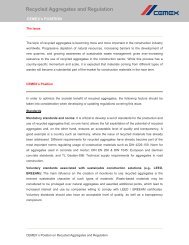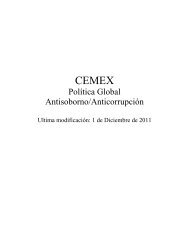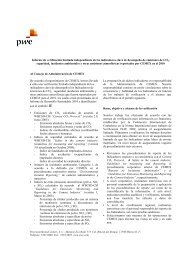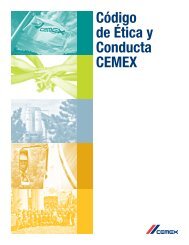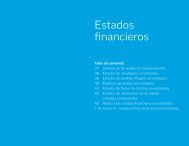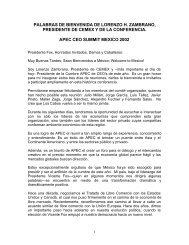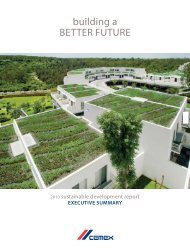building a STRONGER foundation - Cemex
building a STRONGER foundation - Cemex
building a STRONGER foundation - Cemex
You also want an ePaper? Increase the reach of your titles
YUMPU automatically turns print PDFs into web optimized ePapers that Google loves.
During 2009, we reduced the aggregate notional amount of our derivatives, thereby reducing the risk of cash margin calls. This<br />
initiative included closing substantially all notional amounts of derivative instruments related to our debt (currency and interest rate<br />
derivatives) and the settlement of our inactive derivative financial instruments, which we finalized during April 2009. The Financing<br />
Agreement and other debt instruments significantly restrict our ability to enter into derivative transactions.<br />
As of December 31, 2010, our derivative financial instruments that had a potential impact on our comprehensive financing result<br />
consisted of equity forward contracts on third party shares and equity derivatives under our own shares (including our capped call<br />
transactions in connection with the 2010 Optional Convertible Subordinated Notes, which we closed in March 2010), a forward<br />
instrument over the Total Return Index of the Mexican Stock Exchange and interest rate derivatives related to energy projects. See<br />
note 12C to our consolidated financial statements included elsewhere in this annual report. We have recently entered into capped call<br />
transactions with several financial institutions in connection with the issuance of the 2011 Optional Convertible Subordinated Notes.<br />
See “Item 5 — Operating and Financial Review and Prospects — Recent Developments — Recent Developments Relating to Our<br />
Indebtedness.”<br />
Most derivative financial instruments are subject to margin calls in case the threshold set by the counterparties is exceeded. If<br />
we resume using derivative financing instruments in the future, the cash required to cover margin calls in several scenarios may be<br />
substantial and may reduce the funds available to us for our operations or other capital needs. The mark-to-market changes in some of<br />
our derivative financial instruments are reflected in our statement of operations, which could introduce volatility in our controlling<br />
interest net income and our related ratios. In the current environment, the creditworthiness of our counterparties may deteriorate<br />
substantially, preventing them from honoring their obligations to us. We maintain equity derivatives that in a number of scenarios may<br />
require us to cover margin calls that could reduce our cash availability. If we resume using derivative financing instruments, or with<br />
respect to our outstanding or new equity derivative positions, we may incur net losses from our derivative financial instruments. See<br />
“Item 5 — Operating and Financial Review and Prospects — Critical Accounting Policies — Derivatives Financial Instruments.”<br />
Higher energy and fuel costs may have a material adverse effect on our operating results.<br />
Our operations consume significant amounts of energy and fuel, the cost of which has significantly increased worldwide in 2011<br />
and in recent years. Energy and fuel prices have recently increased and may continue to increase as a result of the political turbulence<br />
in Egypt, Libya and other countries in Africa and the Middle East. In an attempt to mitigate high energy and fuel costs and volatility,<br />
we have implemented the use of alternative fuels such as tires, biomass and household waste, which is designed to make us less<br />
vulnerable to price spikes. We have also implemented technical improvements in several facilities and entered into long-term supply<br />
contracts of petcoke and electricity to mitigate price volatility. Despite these measures, we cannot assure you that our operations<br />
would not be materially adversely affected in the future if energy and fuel costs increase.<br />
A substantial amount of our total assets consists of intangible assets, including goodwill. We have recognized charges for<br />
goodwill impairment in the past, and if market and industry conditions continue to deteriorate further, impairment charges may be<br />
recognized. Our charges for impairment may be materially greater under U.S. GAAP than under MFRS.<br />
As of December 31, 2010, approximately 40% of our total assets were intangible assets, of which approximately 69%<br />
(Ps142,094 million) corresponded to goodwill related primarily to our acquisitions of RMC Group, p.l.c., or RMC, and Rinker.<br />
Goodwill is recognized at the acquisition date based on the preliminary allocation of the purchase price to the fair value of the assets<br />
acquired and liabilities assumed. If applicable, goodwill is subsequently adjusted for any correction to the preliminary assessment<br />
given to the assets acquired and/or liabilities assumed within the twelve-month period following the purchase date.<br />
Our consolidated financial statements have been prepared in accordance with MFRS, which differ significantly from U.S.<br />
GAAP with respect to the methodology used to determine the final impairment loss, when applicable, including the selection of key<br />
economic assumptions related to the determination of the discount rates used to assess our assets’ fair value. Pursuant to our policy<br />
under MFRS, goodwill and other intangible assets of indefinite life are not amortized and are tested for impairment when impairment<br />
indicators exist or in the fourth quarter of each year, by determining the value in use of the reporting units to which those intangible<br />
assets relate (a reporting unit comprises multiple cash generating units), which is the result of the discounted amount of estimated<br />
future cash flows expected to be generated by the reporting units. An impairment loss is recognized under MFRS if the value in use is<br />
lower than the net book value of the reporting unit. We determine the discounted amount of estimated future cash flows over a period<br />
of five years, unless a longer period is justified in a specific country, considering the economic cycle of the reporting units and<br />
prevailing industry conditions. Impairment tests are sensitive to the projected future prices of our products, trends in operating<br />
expenses, local and international economic trends in the construction industry, as well as the long-term growth expectations in the<br />
different markets, among other factors. We use after-tax discount rates, which are applied to after-tax cash flows for each reporting<br />
unit. Undiscounted cash flows are significantly sensitive to the growth rates in perpetuity used. Likewise, discounted cash flows are<br />
significantly sensitive to the discount rate used. The higher the growth rate in perpetuity applied, the higher the amount obtained of<br />
undiscounted future cash flows by reporting unit. Conversely, the higher the discount rate applied, the lower the amount obtained of<br />
discounted estimated future cash flows by reporting unit. See note 11B to our consolidated financial statements included elsewhere in<br />
this annual report.<br />
11



